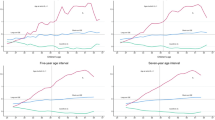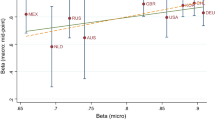Abstract
This paper examines whether reported income generates biases for studies on economic mobility and poverty dynamics. Using a linear measurement error model capturing mean-reverting measurement error, this study finds that substantial classical measurement error exists in reported data, leading to a bias toward zero in the estimate of income dynamics. Time-invariant non-classical measurement error and unobserved heterogeneity offset the effect of classical measurement error. This study also identifies the standard deviation of the measurement error, which is estimated to be about 70% of that of the equation error in the income model, suggesting that random measurement error is substantial.
Similar content being viewed by others
Notes
Estimating \(\gamma \) and \(\beta \) never requires an assumption of homoskedasticity, but \(\varepsilon _{it}\) will be restricted to be homoskedastic for the variance of measurement error decomposition introduced in Sect. 2.3. This study also proposes specification tests to examine the AR(1) model, which will be introduced shortly. The tests also examine if the errors in the model is serially correlated.
If one is willing to ignore measurement error, the AR(1) model in this paper can be also derived from the earnings dynamics model in the macroeconomics literature by linking the current and lagged income through the AR(1) shock components. This study cannot exclude the possibility that the persistence of income is indeed solely from the persistence of shocks (or of time-varying omitted variables) after controlling observed and unobserved (if fixed) individual characteristics
If external IVs are valid while internal IVs are not, the use of only external IVs can also present consistent estimates. External IVs are also used for both estimates using the internal IVs that include and exclude \(y_{it-2}\) to identify measurement error avoiding a potential weak instruments problem.
Note that the error term can be regarded to be MA(2) in level, but this paper takes it as MA(1) for a differenced term (i.e., \(\Delta v_{it-1} \equiv \psi _{it-1} \)).
It can be shown that summing ARMA(p, q) processes yields a ARMA(p, q) process. The composite error could be the sum of MA(1) equation error and MA(1) measurement error.
General sequential exogeneity means that \(\varepsilon _{it}\) is uncorrelated with the current or past values of the household heads’ satisfaction, but this study does not assume that \(\varepsilon _{it}\) is uncorrelated with the current value of the external instrument.
The EWMD estimation method has been extensively used in the labor/macroeconomics literature identifying different types of error variances (e.g., Meghir and Pistaferri (2004)).
All income is after-tax income in units of 10,000 won (\(\approx 9\) dollars) for the year 2000.
Since adding one could be criticized as an arbitrary choice, additional robustness checks are conducted. The estimates of \(\gamma \) show robustness according to adding the numbers from 0.05 to 2.
Other variables change over two years only for 1 to 5% of all observations (i.e., 95–99% are time-invariant and so zero by first-differencing), while 10% out of all observations change household size over two years. Only household size is included to control for possible economies of scale.
Note that the external IVs (income satisfaction at t-2 and t-3) are also used for the purpose of comparison with the other results in addition to the internal IVs, \(y_{it-2}\) and \(y_{it-3}\). However, it is worth note here that the number of IVs in this study are limited; only up to two lags of income and income satisfaction variables are used. The earlier values of the instruments (that is, t-4 and so on) can be also used, but it is well known that too many instruments can cause severe overfitting biases (Bun et al. 2015). The literature found that omitting distant lags based on the overidentification tests can help avoid the potential problem of too many instruments (Bond 2002; Windmeijer 2005). In particular, Windmeijer (2005) finds that using only two lags of the dependent variable as instruments appeared to decrease the average bias by 40% relative to the estimator that made use of the full set of instruments. With the same reason, time-varying characteristics of previous periods (i.e., \(x_{it-s}\)) are also not used as instruments.
The result is available upon request.
The estimate is 1.19 with .16 bootstrap standard errors obtained by 1,000 repetitions.
They use the OLS method with validation data. Bound and Krueger and Bollinger use CPS-SSA matched files, and Bound et al use the PSID validation study.
References
Antman F, McKenzie DJ (2007) Earnings mobility and measurement error: a pseudo-panel approach. Econ Dev Cult Change 56(1):125–161
Arellano M, Bond S (1991) Some tests of specification for panel data: Monte carlo evidence and an application to employment equations. Rev Econ Stud 58(2):277–297
Bollinger CR (1998) Measurement error in the current population survey: a nonparametric look. J Law Econ 16(3):576–594
Bollinger CR, Chandra A (2005) Iatrogenic specification error: a cautionary tale of cleaning data. J Law Econ 23(2):235–257
Bond SR (2002) Dynamic panel data models: a guide to micro data methods and practice. Port Econ J 1(2):141–162
Bound J, Brown C, Mathiowetz N (2001) Measurement error in survey data. In: Handbook of econometrics, vol 5, pp 3705–3843. Elsevier
Bound J, Krueger AB (1991) The extent of measurement error in longitudinal earnings data: do two wrongs make a right? J Law Econ 9(1):1–24
Bun MJ, Sarafidis V, et al (2015) Dynamic panel data models. The Oxford handbook of panel data, pp 76–110
Daniels L (2001) Testing alternative measures of microenterprise profits and net worth. J Develop Stud Assoc 13(5):599–614
Deaton A (1997) The analysis of household surveys: a microeconometric approach to development policy. The World Bank
Glewwe P, Dang H-AH (2011) Was vietnam’s economic growth in the 1990s pro-poor? an analysis of panel data from vietnam. Econ Dev Cult Change 59(3):583–608
Holtz-Eakin D, Newey W, Rosen HS (1988) Estimating vector autoregressions with panel data. Econom J Econom Soc 56(6):1371–1395
Jappelli T, Pistaferri L (2010) The consumption response to income changes. Ann Rev Econ 2:479–506
Kapteyn A, Ypma JY (2007) Measurement error and misclassification: a comparison of survey and administrative data. J Law Econ 25(3):513–551
Kim B, Solon G (2005) Implications of mean-reverting measurement error for longitudinal studies of wages and employment. Rev Econ Stat 87(1):193–196
Lillard LA, Willis RJ (1978) Dynamic aspects of earning mobility. Econom J Econom Soc 46(5):985–1012
Lokshin M, Ravallion M (2004) Household income dynamics in two transition economies. Stud Nonlinear Dynam Econom, 8(3)
MaCurdy TE (1982) The use of time series processes to model the error structure of earnings in a longitudinal data analysis. J Econom 18(1):83–114
McCulloch N, Baulch B (2000) Simulating the impact of policy upon chronic and transitory poverty in rural Pakistan. J Develop Stud 36(6):100–130
Meghir C, Pistaferri L (2004) Income variance dynamics and heterogeneity. Econometrica 72(1):1–32
Meghir, C. and Pistaferri, L. (2011). Earnings, consumption and life cycle choices. In: Handbook of labor economics, vol 4, pp 773–854. Elsevier
Meijer E, Spierdijk L, Wansbeek T (2015) Measurement error in panel data. In: The Oxford Handbook of Panel Data
Meyer BD, Mok WK, Sullivan JX (2015) Household surveys in crisis. J Econom Perspect 29(4):199–226
Morgenstern O et al (1963) On the accuracy of economic observations. Princeton University Press, New Jersey
Windmeijer F (2005) A finite sample correction for the variance of linear efficient two-step gmm estimators. J Econom 126(1):25–51
Acknowledgements
I would like to thank John Strauss, John Gibson, John Ham, Jungmin Lee, David McKenzie, Roger Moon, Jeffrey Nugent, Masao Ogaki, Geert Ridder, and participants at North American Summer Meeting of the Econometric Society, Asian Meeting of the Econometric Society, Northeastern Universities Development Consortium Conference, Southern Economic Association Annual Meeting, Pacific Conference for Development Economics, and seminars at Chinese University of Hong Kong, Sogang University, University of Southern California. All remaining errors are mine.
Author information
Authors and Affiliations
Ethics declarations
Conflict of interest
The author declares no specific funding for this study and no conflicts of interest. Since this study uses non-experimental and publicly available survey data, no additional ethical approval is required.
Additional information
Publisher's Note
Springer Nature remains neutral with regard to jurisdictional claims in published maps and institutional affiliations.
Rights and permissions
About this article
Cite this article
Lee, N. Measurement error and its impact on estimates of income dynamics. Empir Econ 63, 2539–2550 (2022). https://doi.org/10.1007/s00181-022-02218-4
Received:
Accepted:
Published:
Issue Date:
DOI: https://doi.org/10.1007/s00181-022-02218-4




